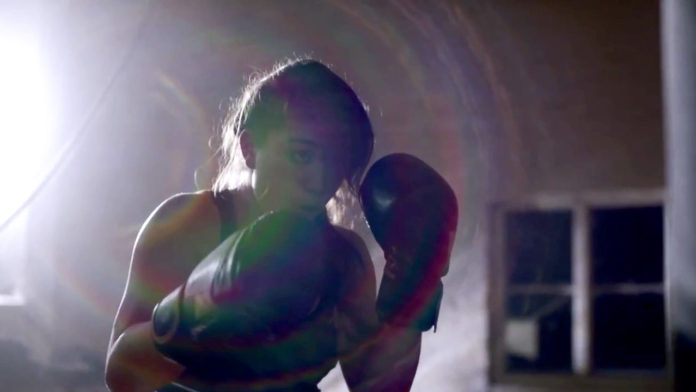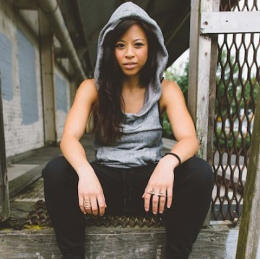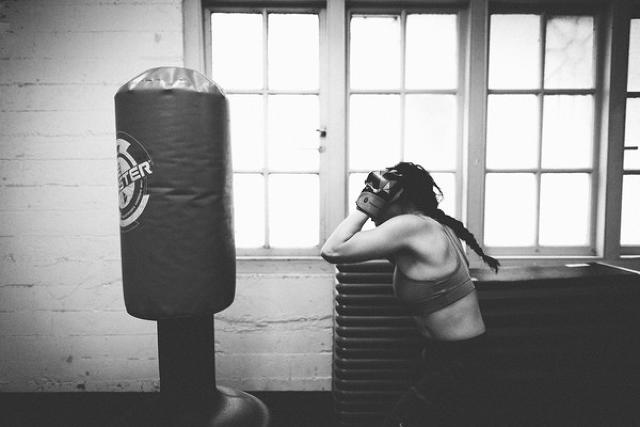
Women athletes have made great strides in recent years. In 2012, 4,847 women competed in the London Olympic games, the most ever in Olympic history. Not only that, women represented every country in every sport that year, and CBS Sports launched the first all-female sports talk show, We Need To Talk, in September 2014.
However, the battle for gender equality in sports is still very much ongoing. Underrepresentation, misrepresentation, sexualization, and a lack of suitable of equipment and attire are just a few facets of the plight of many female athletes, particularly women in combat sports.
Of course, this isn’t something an entrepreneurial female fighter will take lying down. Enter Krav Maga fighter and former kickboxing instructor, Lynn Le. She’s buildingSociety Nine, an equipment and apparel brand intended to align with the strength, femininity, and physical diversity of women who get in the ring and embrace sports and fitness across the board.

Women make up nearly 25% of the $50 billioncombat sports market, which includes fitness, product, and entertainment in the U.S. As more women are exposed to empowerment through sports, brands promoting athleticism in women are being created and harnessed as more than just marketing tools. They are becoming necessary for fueling a movement based on what female athletes and fitness pros define as valuable versus what society finds acceptable.
“I created Society Nine as a response to my frustration with fashion fitness media and the message that we [female fighters] are expected to work hard purely for our physique,” says Lynn Le. “This image has to change.”
As female fighters, Le and her peers go head to head with a number of stereotypes on a regular basis. One stereotype they’re working to dispel labels women who are in the sport as wanting to attract attention from men. Another ceiling they’re aiming to burst through is the size comparison quandary.
“We often have to deal with male training partners taking it easy on us just because we’re female,” shares Le, who is 4-foot-11, and has sparred with men who are 6-foot-4.
“It’s interesting to me, the responses I get from men when I tell them that Society Nine is a combat sports brand for women,” says Le. “Sometimes it’s laughs. Other times it’s smirks. I do get the occasional, ‘that’s badass, good for you!’ So I’ll give some of those guys credit. But for those that laugh or smirk, all they see in their heads are pink gloves—something not to be taken seriously. We are here to wake them up!”
Historically, women in boxing have been ring girls wearing bikinis and holding signs.
And like every male dominated industry, society deems women who are successful in sports as masculine unless they prove otherwise. In 2015, one would hope there’s no need to negotiate femininity and masculinity in terms of athleticism. But sports is a social institution just like any other that exists under a societal construct where the gender gap is blatant in pay, media coverage, and general recognition of competence. This is part and parcel of the reason so many images of women in sports and fitness are hypersexualized.
So what’s it going to take for a new institution to evolve?
Society Nine advocate and Krav Maga instructor Jazzy Green says it’s all in the marketing.
“There’s an obvious line that has been crossed that dictates that fitness is for sexual beauty,” says Green. “Fitness should be for movement and being able to live life in a healthy strong body. The focus of any marketing towards fitness should be about free enjoyable movement and the possibilities for men or women. Women must be a part of the change as well and take hold of the reins.”

Taking hold of the reins with both hands is precisely what Le and the Society Nine team are doing with their crowdfunding campaign intended to support themanufacturing of their first line of products, including a set of MMA (mixed martial arts) gloves launching in the fall. The gloves, which are inspired by the idea of shattering glass, are being engineered to address the most common problems for women fighters when it comes to equipment and apparel—fit and design. From the glove’s padding to its curves, color, and function, Le and company are doing a lot more than shrinking the size of a man’s boxing gloves and throwing pink on them like many boxing apparel brands do. In the last 18 months, Society Nine has taken its product concepts from sketches to multiple prototyping sessions with professional and amateur fighters and trainers.
“Yes, MMA is a male-dominated market in terms of viewership and participation, but it’s not like that any more, and what we are saying is there are other ways,” says Le. “We are offering that platform to defy the stereotype or expectation. The exciting thing is that combat sports are brewing among women practicing, and there is an opportunity to brand ourselves differently to appeal to a female market progressive in its thinking.”
Green agrees that it’s time for the burgeoning community of women in combat sports to shift the social construct around female fighters by promoting and fulfilling what these women want and need.
Green says, “Not only will the brand support those who choose to train in fighting, but it will naturally inspire the future generations as the world changes its views of what is possible. Overall, it is time to see conscious steps towards shifting the patriarchal paradigm, and in this case it’s by not only being women fighters, but having the gear needed for it.”
As Society Nine’s Kickstarter page highlights: The female fight is greater than the sport. But the sport is where we begin.
—Melissa Jun Rowley is a journalist and entrepreneur focused on the intersection of social justice and tech, race, gender, and youth advocacy. She currently runs The Toolbox, a site dedicated to spotlighting tools aiding social change and connecting activists and developers, and is writing a book about the power of young people using STEAM (Science, Technology, Engineering, Art & Math) to transform communities.


















